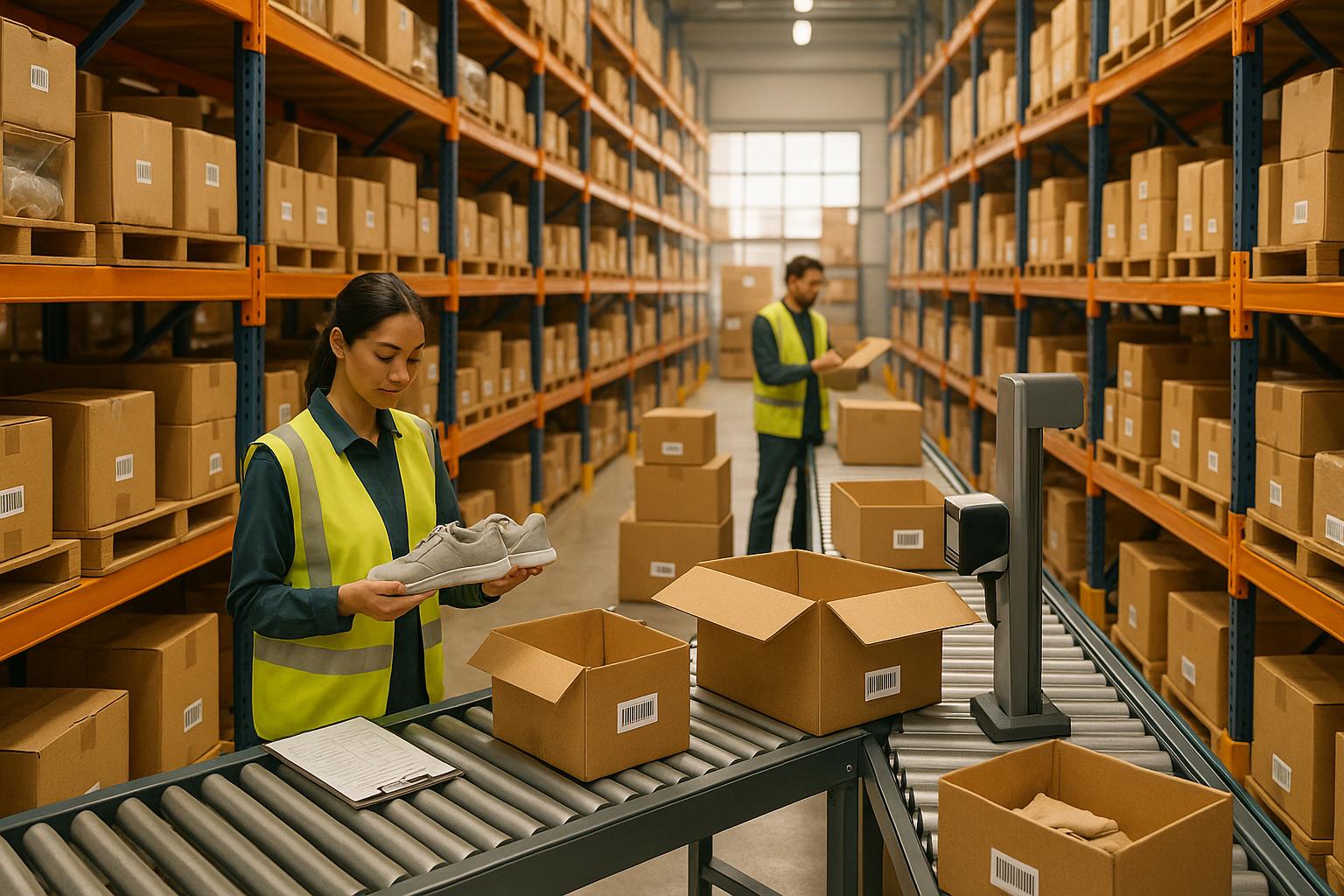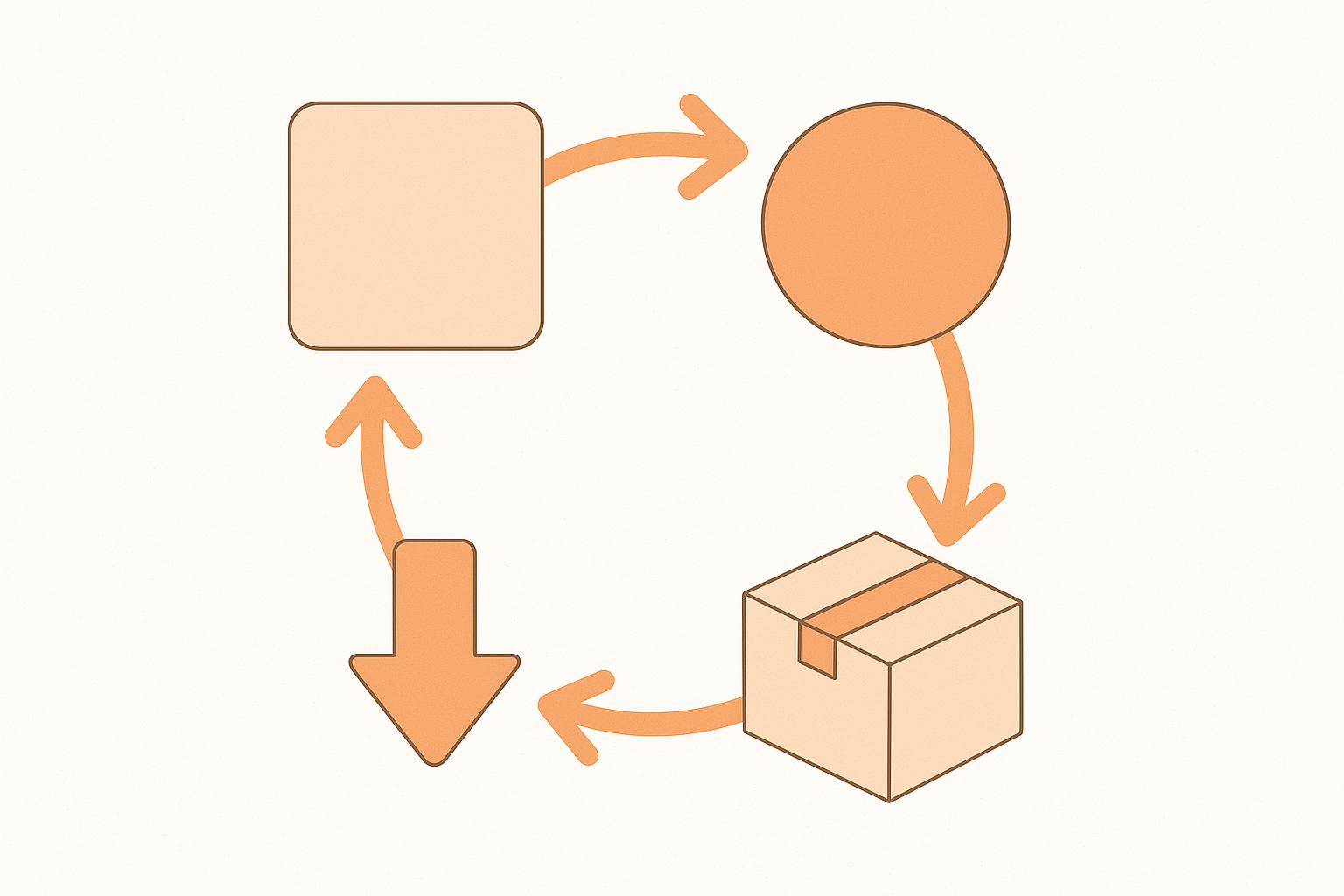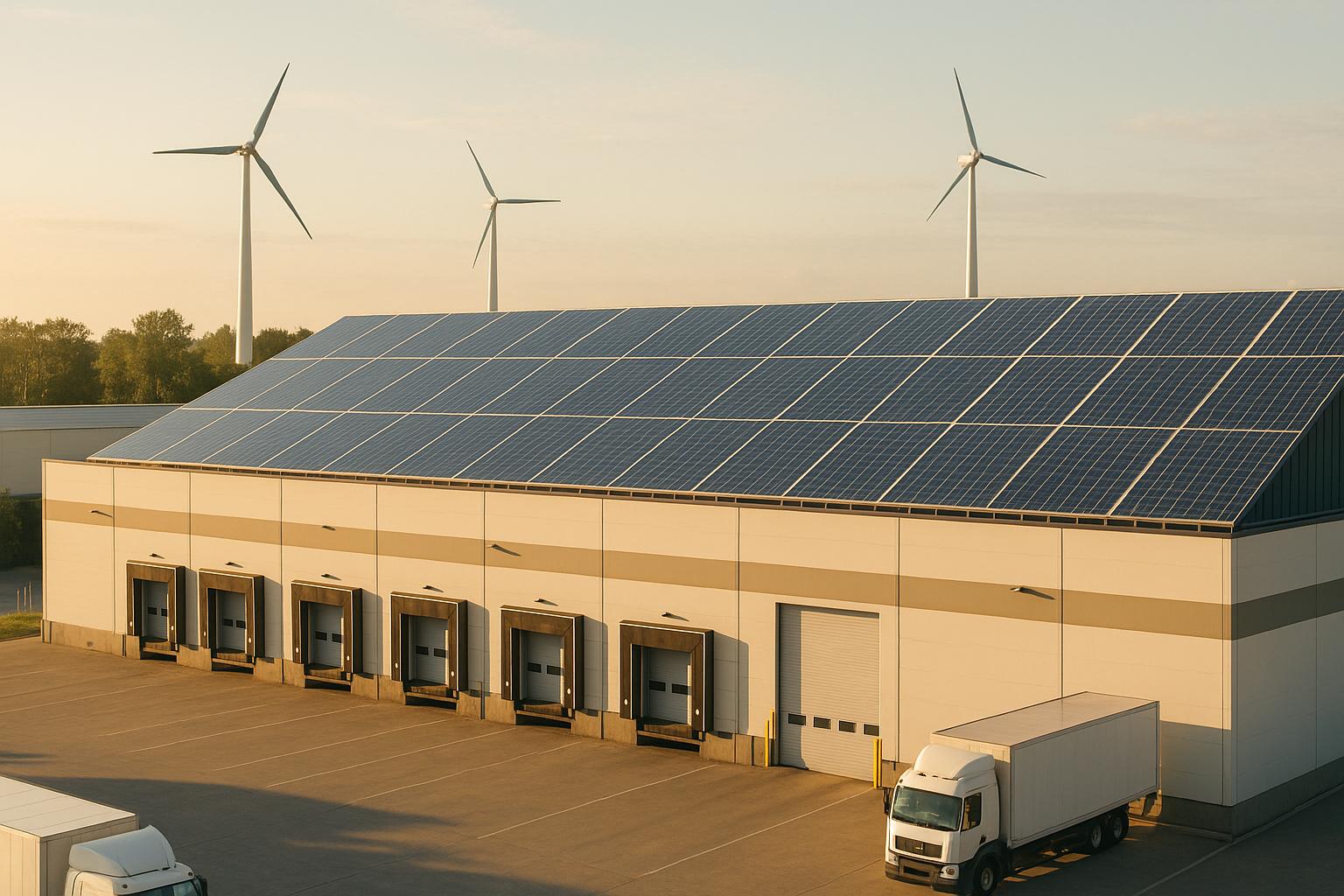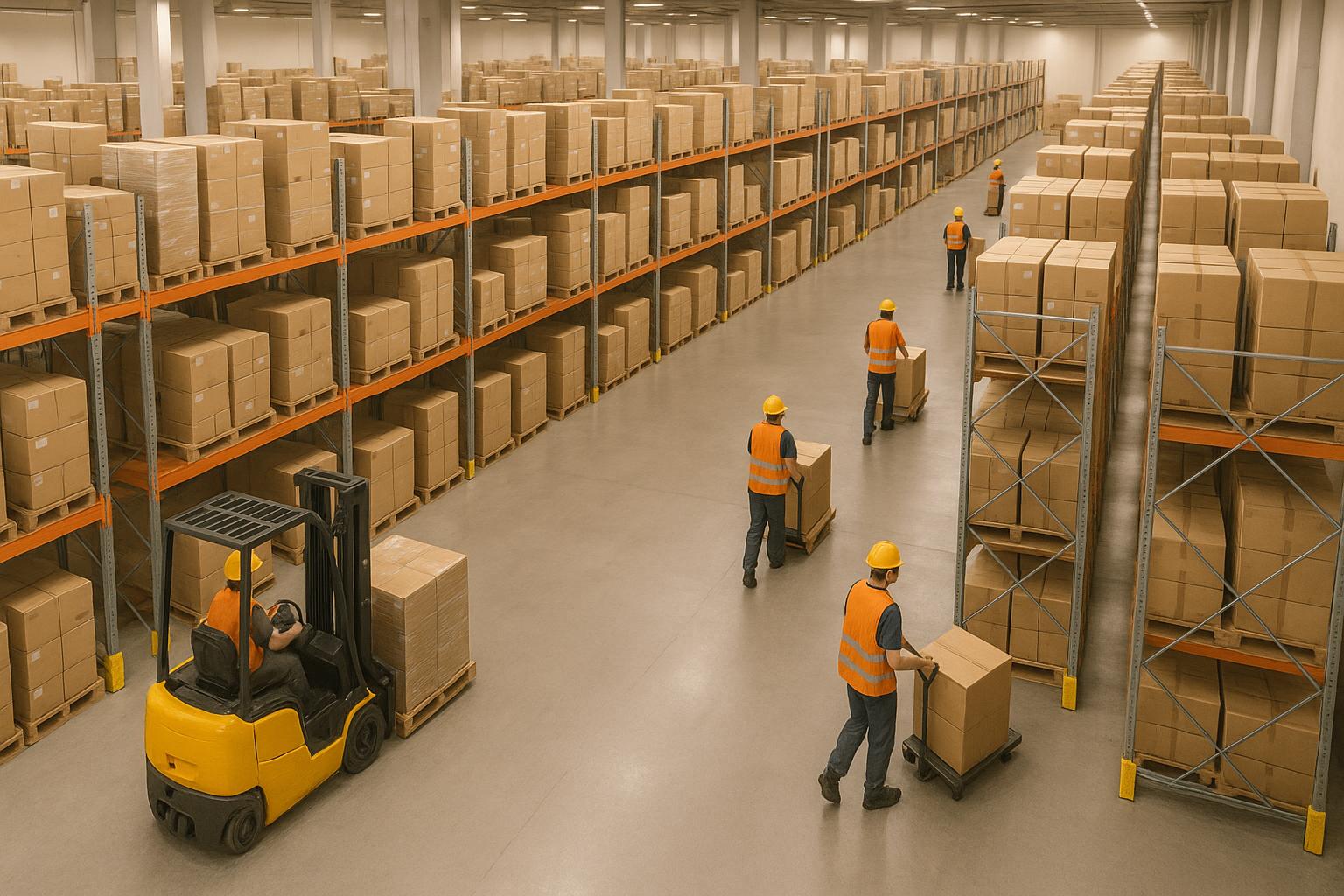How 3PLs Support Scalable Reverse Logistics

Reverse logistics - managing product returns - is a growing challenge for e-commerce brands. As online shopping expands, so do return rates, creating unpredictable volumes, high costs, and operational hurdles. Customers expect hassle-free returns, making an efficient system crucial for maintaining loyalty and reputation.
Key Takeaways:
- Reverse logistics involves receiving, inspecting, and processing returns, which can be costly and complex.
- Challenges include inconsistent return volumes, high transportation costs, and managing returned inventory.
- Third-party logistics (3PLs) help brands handle returns efficiently, offering tailored solutions, technology, and nationwide infrastructure.
Reverse Logistics with Chuck Fuerst
Core Components of Scalable Reverse Logistics
Scalable reverse logistics relies on a well-coordinated system of components that can handle growing return volumes without faltering. Here’s a closer look at the key elements that make reverse logistics scalable and efficient.
Returns Management and Policy Development
A strong returns policy is the cornerstone of effective reverse logistics, balancing customer satisfaction with operational efficiency.
E-commerce brands face the challenge of creating return policies that are flexible enough for customers but practical for their operations. For instance, electronics often come with shorter return windows due to rapid value depreciation, while clothing might allow longer periods.
Clear eligibility criteria are essential to avoid confusion and streamline the process. These criteria should outline which items qualify for returns, the required condition, and any exceptions. For example, personalized products, perishable goods, or hygiene-sensitive items often have stricter rules. By defining these guidelines upfront, brands can minimize customer inquiries and speed up processing.
As return volumes grow, automated policy enforcement becomes indispensable. Instead of relying on manual reviews by customer service teams, technology can automatically approve or flag returns based on predefined rules. This ensures consistency, reduces human error, and saves time across all channels.
With these policies in place, the subsequent steps in handling returned products become much more efficient.
Returns Processing and Product Handling
The way returns are processed - from inspection to reintegration - directly affects costs and turnaround times. Each item goes through a series of steps, and how well these are managed can significantly impact profitability.
Inspection and categorization are critical first steps. Returned items must be quickly assessed for their condition and routed accordingly. Items in perfect condition can go back into inventory, those with minor issues may need cleaning or repackaging, and damaged goods might require repair, liquidation, or disposal.
At scale, speed becomes critical. A process that works for 50 returns a day won’t suffice for 500. Standardized inspection procedures can help maintain consistency while shortening the time spent on each item. Defining clear condition categories - such as "new", "like new", "good", and "damaged" - enables quicker decision-making.
Reintegrating inventory adds unique challenges compared to forward logistics. Unlike new stock, returned items arrive sporadically and in varying conditions. This requires tailored handling procedures. A warehouse management system (WMS) must track these items separately and ensure they pass through the necessary quality checks before being added back to sellable inventory.
For items that aren’t immediately sellable, refurbishment capabilities can make a big difference. Simple repairs, cleaning, or repackaging can turn unsellable goods into revenue-generating inventory. However, this requires dedicated facilities, skilled staff, and clear cost-benefit analyses to determine when refurbishment is worth the investment.
Efficient product handling relies heavily on advanced technology, which we’ll explore next.
Technology and Infrastructure Requirements
Scalable reverse logistics demand technology that can handle the complexity and volume of returns.
Real-time tracking systems are essential for providing visibility throughout the returns process. Just as customers expect tracking for outbound shipments, they also want updates on their returns. Transparency not only reduces customer service inquiries but also builds trust in the returns process.
A WMS designed for reverse logistics must handle the unpredictable nature of returned items. Unlike new inventory, returns often arrive individually and in mixed conditions. Advanced systems can assign items to specific inspection stations, monitor processing times, and optimize workflows based on warehouse capacity.
Data analytics play a crucial role as operations grow. Analyzing return patterns can uncover product quality issues, seasonal trends, and areas for improvement. For example, analytics can highlight which products have high return rates, common reasons for returns, and the most cost-effective ways to process different types of items.
To avoid inefficiencies, seamless integration across e-commerce, customer service, and accounting systems is vital. For instance, when a return is processed, inventory levels should update automatically, refunds should be triggered, and relevant teams should be notified - all without manual intervention.
Finally, automation technologies like barcode scanners, sorting systems, and robotic process automation can dramatically improve efficiency. Although the upfront investment might seem high, these tools often pay off by cutting labor costs and speeding up processing as return volumes rise.
How 3PLs Enable Scalable Reverse Logistics
Third-party logistics providers (3PLs) turn what might seem like a logistical headache - reverse logistics - into an opportunity for growth. By pooling shared resources, leveraging their expertise, and implementing proven systems, 3PLs make it easier for e-commerce brands to manage returns as they expand. This approach eliminates the need for brands to invest in dedicated warehouses, specialized staff, or complex technology, making advanced reverse logistics accessible and cost-effective.
Custom Returns Management Solutions
One of the standout capabilities of 3PLs is their ability to design returns processes tailored to the specific needs of each brand and its customers. These workflows cover everything from return authorization to final disposition, ensuring a smooth and efficient operation.
For example, automated systems streamline the approval process for lower-value returns, while higher-value items undergo more thorough verification. The same pick-and-pack expertise used in order fulfillment is applied to reverse logistics, enabling quick processing of returns while simultaneously managing exchanges or replacement orders.
For brands dealing with complex returns, such as missing components or accessories, 3PLs offer kitting and assembly services. Take electronics companies, for instance - when returned items are incomplete, a 3PL can reassemble product kits, verify all parts are present, and repackage them for resale.
JIT Transportation is a great example of how 3PLs enhance reverse logistics. Their return merchandise authorization (RMA) processing includes detailed inspection, categorization, and disposition decisions. Paired with their robust pick-and-pack capabilities, they ensure quick turnaround times for exchanges and replacements, making the process seamless for both brands and customers.
But custom processes are just one piece of the puzzle. A wide-reaching network is equally essential for scaling reverse logistics.
Nationwide Networks and Warehouse Locations
In addition to tailored solutions, 3PLs offer expansive networks of warehouses strategically located across the country. This setup allows returns to be handled regionally, cutting shipping distances and costs while speeding up processing times.
By managing returns closer to their origin, particularly for bulky items, brands can significantly reduce freight expenses and customer fees. Regional processing also enables faster refunds and exchanges, which improves customer satisfaction.
Beyond cost savings, 3PLs optimize logistics through consolidation. For example, items approved for resale can be combined with regular inventory shipments, reducing transportation costs even further. Strategically placed facilities make the entire process more efficient, from initial return to final resolution.
Value-Added Services for Business Growth
3PLs go beyond simple returns processing by offering value-added services that turn returned products into opportunities. Rigorous testing and revision services ensure that returned items meet resale standards, allowing them to re-enter the market with confidence.
For high-value or delicate items, white glove handling is essential. This service involves careful inspection, proper storage, and expert repackaging to maintain product quality and protect a brand’s reputation.
JIT Transportation showcases how these services can enhance reverse logistics. Their testing and revision processes ensure returned items meet quality standards, while their white glove handling preserves the integrity of premium products, maximizing recovery value.
Another key offering is vendor-managed inventory (VMI). With VMI, 3PLs monitor and manage returned items in real time, enabling immediate decisions about disposition, restocking, and reordering. This reduces the need for constant oversight from the brand, streamlining operations.
Without these specialized systems and expertise, managing returns at scale can quickly become overwhelming. That’s why 3PLs are an ideal solution for businesses looking to handle reverse logistics efficiently while still growing.
sbb-itb-eafa320
Strategies for Optimizing Reverse Logistics at Scale
Scaling reverse logistics effectively takes a mix of strategic planning, smart technology adoption, and a commitment to ongoing improvement. Done right, it can turn what’s traditionally seen as a cost-heavy process into a real competitive edge.
Using Data-Driven Insights
Leveraging data is key to identifying inefficiencies and opportunities within your returns process. For example, frequent sizing issues or missing accessories might point to deeper operational problems that need fixing.
Tracking seasonal trends is another important step. By analyzing historical data, businesses can better prepare for peak return periods, ensuring they have adequate staffing and warehouse capacity to avoid bottlenecks.
Regularly reviewing return metrics helps companies spot new patterns early, allowing for proactive adjustments. This data forms the foundation for introducing automation, which can further streamline operations and eliminate repetitive tasks.
Implementing Automation and Technology
Automation is a game-changer for reverse logistics. By automating repetitive tasks, businesses can cut down on processing times, improve accuracy, and free up employees to handle more complex issues.
Take automated return authorization systems, for example. These systems use predefined criteria - such as purchase date, reason for return, or customer history - to quickly process low-risk returns while flagging exceptions for manual review. Barcode scanning and integrated inventory systems ensure that returned items are logged accurately, triggering the correct workflows and keeping inventory levels up to date.
Mobile tools also play a role, giving staff access to real-time updates, which improves coordination across teams. Meanwhile, predictive analytics can forecast return volumes, helping businesses allocate resources more effectively. The idea is simple: let machines handle routine tasks so your team can focus on big-picture strategies and improving customer experiences.
Implementing Green Practices in Reverse Logistics
Sustainability isn’t just good for the planet - it can also cut costs and enhance your brand’s appeal to eco-conscious customers. By reducing waste and recovering value from returned items, businesses can lower disposal expenses while demonstrating environmental responsibility.
Refurbishing products or harvesting components from defective items is one way to recapture value. Recycling partnerships can ensure that items at the end of their lifecycle are responsibly processed, recovering raw materials and sometimes even generating additional revenue.
Smarter packaging - like using reusable materials or tailoring box sizes to shipments - reduces waste and lowers shipping costs. Route optimization in transportation can further minimize fuel use and emissions, slashing operational expenses. Tracking your carbon footprint and setting measurable goals shows a commitment to sustainability.
When integrated into a broader reverse logistics strategy, these green initiatives prove that environmental responsibility can align with economic goals, creating a win-win for businesses and the planet.
Case Study: Scalable Reverse Logistics with JIT Transportation

JIT Transportation has turned reverse logistics into a strategic advantage for e-commerce brands. By combining tailored solutions with a network of distributed infrastructure, they help businesses manage the ever-growing volume of returns without sacrificing efficiency or customer satisfaction. This case study highlights how their approach reinforces the scalable reverse logistics model we've discussed.
Tailored 3PL Solutions for Returns Management
JIT Transportation offers a range of RMA services, including pick and pack, testing, and revision upgrades, all aimed at maximizing the recovery value of returned items.
For bundled or multi-component returns, JIT meticulously disassembles, inspects, and reassembles products. This process ensures that businesses can recover value from individual components rather than discarding entire product sets due to minor defects. It’s a critical approach for brands dealing with complex or high-value products.
Their specialized white-glove handling service is another standout feature. High-value items like electronics, luxury goods, or fragile products receive expert care to assess their condition and resale potential. This level of precision helps brands uphold their quality standards throughout the reverse logistics process, ensuring customer trust and satisfaction.
Leveraging Technology for Seamless Operations
JIT doesn’t just stop at customized handling - they integrate cutting-edge technology to streamline every step of the process. Their systems provide real-time updates, from RMA creation to final disposition, eliminating manual data entry and giving businesses a clear view of return statuses, inventory, and processing timelines.
These systems also come equipped with analytics tools that dive deep into returns data. By analyzing patterns in return reasons, processing times, and recovery rates across product categories, brands can make smarter decisions about product design, supplier partnerships, and return policies. This data-driven approach turns reverse logistics into a proactive strategy, offering valuable insights that go beyond just managing returns.
Nationwide Network for Efficient Returns Processing
JIT’s strategically located warehouses across the U.S. allow for regional returns processing, reducing shipping costs and speeding up turnaround times.
This regional model is particularly useful during peak seasons when return volumes surge. Instead of overwhelming a single facility, JIT distributes the workload across multiple locations, avoiding bottlenecks and maintaining consistent service levels. Their infrastructure is designed to scale with a brand’s growth - new warehouse locations can be added, existing facilities can increase capacity, and technology systems can handle higher volumes without requiring a complete overhaul.
Additionally, this distributed network offers built-in redundancy. If one facility faces disruptions due to weather, equipment issues, or other challenges, processing can seamlessly shift to another location. This ensures that customer commitments are met, and operations continue smoothly, no matter the circumstances.
Best Practices for Scalable Reverse Logistics with 3PLs
E-commerce brands aiming to scale their reverse logistics should focus on clear policies, smart technology adoption, and working with 3PLs that can grow with them.
Start by crafting clear return policies that strike a balance between keeping customers happy and maintaining operational efficiency. These policies should spell out return windows, product condition requirements, and processing timelines. When expectations are crystal clear, it reduces confusion for customers and warehouse teams, speeding up processing and minimizing disputes.
Next, incorporate real-time tracking and analytics into your returns process. Analytics tools can uncover patterns that inform smarter decisions. For example, you can identify recurring product quality issues or predict seasonal return trends to adjust staffing levels accordingly. This data-driven approach ensures you're always one step ahead.
Using multiple regional warehouses is another smart move. It cuts down on shipping costs and processing times while also providing a safety net in case of unexpected disruptions. This setup improves efficiency and keeps operations running smoothly, even during challenges.
When it comes to value recovery, tailor your approach to the specific product category. Electronics might need testing and refurbishment, while clothing could require cleaning and repackaging. By handling each category appropriately, you can maximize the recovery value of returned items.
Regular performance reviews are essential as your returns volume grows. Monthly evaluations of metrics like processing times, recovery rates, and customer satisfaction can highlight areas that need attention before they become major issues. Strong partnerships with 3PL providers thrive on open communication, with both sides working together to refine processes based on real-world data.
Prepare for both steady growth and unexpected spikes by partnering with 3PLs that can scale capacity quickly without sacrificing quality. Whether it's a busy holiday season, a product launch, or a sudden quality issue, having a partner that can adapt ensures smooth operations during high-pressure periods.
Finally, choose 3PL providers with the right mix of nationwide infrastructure, advanced technology, and specialized handling capabilities. Look for partners who offer transparent reporting, flexibility, and a proven ability to grow alongside your business. The right partnership can make all the difference in building a scalable reverse logistics strategy.
FAQs
How do 3PLs tailor reverse logistics to meet the unique needs of e-commerce brands?
Third-party logistics (3PL) providers play a key role in reverse logistics by developing tailored return processes that cater to a brand's unique needs. This involves handling product returns, performing quality checks, and managing repackaging or refurbishment to prepare items for resale or environmentally responsible disposal.
With the help of advanced technology and scalable systems, 3PLs simplify these operations, boosting efficiency, cutting costs, and ensuring a smooth experience for customers. Their adaptable services are especially valuable for growing e-commerce brands, enabling them to handle increasing return volumes without compromising on quality or satisfaction.
How does technology make reverse logistics more efficient and scalable?
Technology has revolutionized reverse logistics, giving businesses the tools they need to simplify processes and grow efficiently. With advancements like AI, automation, and integrated IT systems, companies can now track returns in real time, streamline sorting and inspection, and cut down on operational costs.
Beyond efficiency, these technologies bring added benefits. They improve visibility across the supply chain, support environmentally conscious practices, boost customer satisfaction, and help recover more value from returned items. For fast-growing e-commerce brands, these innovations make it easier to manage returns while staying scalable and dependable.
What are the benefits of adopting eco-friendly practices in reverse logistics for e-commerce brands?
Adopting environmentally mindful practices in reverse logistics allows e-commerce brands to cut down on waste, improve recycling processes, and prolong the life of their products. These actions don't just help reduce operational expenses - they also contribute to a more sustainable approach and align with the principles of a circular economy.
On top of that, integrating green initiatives can elevate a brand's reputation and appeal to eco-conscious consumers, benefiting both the environment and the business's bottom line.
Related Blog Posts
Related Articles

How to Track Reverse Logistics Metrics

Best Practices for Renewable Energy in 3PL Operations

